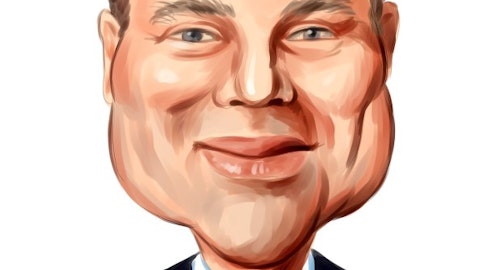Theresa Chen: It does. Thank you. And within the context of capital allocation, you have a healthy balance sheet, ample coverage, JV finance projects and the cash on your balance sheet is building to nearly $1 billion. Can you just remind us how much cash you want to keep on the balance sheet on a ratable basis? Should we just assume that the cash continues to build? What’s the best uses of that cash over the near and medium term?
John Quaid: Theresa, great question. I don’t think we’ve really talked about kind of a targeted cash level for MPLX, right, as a kind of stable midstream entity. It’s not something we’ve been focused on. I think for us, we’ve been focused on how do we optimize that capital allocation. How do we maintain that flexibility for both opportunities to invest in and grow the cash flows of the partnership and other opportunities to continue to grow our return of capital as well. So I think it’s just been a spot of where we are, but we like that flexibility that it gives us for those two levers. Mike, would you…
Michael Hennigan: Yes, Theresa, I’ll add that it wasn’t our desire. We didn’t set out to say let’s end up with $1 billion of cash on the balance sheet. What has disappeared a little bit from the market is the volatility in the unit price. We have a decent amount of that cash that I call red bar that’s targeted to repurchase units. Now we haven’t done that for a little bit of time. It’s not that we’ve given up on that. We just have been surprised at how much tighter the equity price is traded. But if they’re ready to deploy? Is it suboptimal? You could argue that sometimes, but we’re getting a decent interest rate on it right at the moment as we sit here. So it’s not hurting us real bad. And we’re just looking for that opportunity.
So it’s ready to be deployed if we see what we call that opportunistic. At the same time, there’s a portion of that cash that’s what I call blue bar, which is there for the long term. And back to the question that was asked earlier, could we have pushed the distribution more? Yes, we could. We have the financial flexibility to do that. But in our opinion, what we’re trying to do is convince investors that it’s a good longer-term play. We’re not just going to come out and bang it really high and then kind of disappear. We want to show people that we’re going to generate cash flows very consistently. That’s why you’ve heard me say over the last couple of quarters, we’re going to do midstream, I mean, mid-single-digit growth. And it’s not aspirational.
We’ve been doing that since 2019. So that’s part of what we’re trying to convince the market is that we understand if you invest in us, that you want to get a good return, you want to see a growing distribution. We think 10% a couple of years in a row is a good number. By your question, you know that we have more financial capability to do more, and we can just decide to try and manage that over the long term. And if we get a little volatility in the equity, we’ll deploy some repurchasing power as well.
Theresa Chen: Thank you.
Michael Hennigan: You’re welcome.
Operator: Our next question will come from Brian Reynolds with UBS. Your line is open.
Brian Reynolds: Hi. Good morning, everyone. Maybe to follow up on some of the growth expectations for MPLX of which Permian is the large driver. While we’ve seen some of the activity in the Permian weekend as of late, the medium-term outlook for the Permian kind of remains intact with some forecast pointing to greater than 1 million barrels per day of growth from today through year-end ’25. So kind of curious if maybe you can talk a little bit more macro, but it would be great if you could just talk Permian fundamentals from an MPLX perspective, and whether you’re seeing some similar growth trends over a multiyear outlook at the MPLX level? Thanks.
Michael Hennigan: Brian, it’s a good question. I’m going to let Shawn talk a little bit about what were going on in the pipes, whether it’s Wink to Webster or BANGL et cetera, I’ll let them do it, and then let Greg talk a little bit about what we got going in the processing area. As you know, it is an area of focus for us, it’s no secret that there’s a lot of growth in the Permian. And we’re just trying to enable our own ability to get in there and invest prudently and generate cash flows along with all the other competitors are trying to do the same. So Shawn, why don’t you give a little more color on what we got going there?
Shawn Lyon: Sure. Hey, Brian, this is Shawn. Really, I’ll first touch on our NGL pipeline BANGL. Last quarter, we talked about the expansion on that pipeline. And really, that’s been a capital efficient pipeline for us. And as volume has come available, we’ve said we would announce the expansion, and we did that last quarter. So we’re really pleased with that, and that will take us to the Sweeny hub there in Sweeny, Texas. The other Wink to Webster, if you look at that pipeline there, it continues to ramp up as per plan. And really, we’re seeing those cash flows increase over the next couple of years as the commitments continue to ramp up. So again, really pleased with both those long-haul strategic pipelines. And again, they’re measured, but they’re steady and it’s meeting the expectations we thought to return cash to the partnership.
Brian Reynolds: Great. Thanks. And maybe to touch on the Permian natural gas takeaway. We continue to work through all available brownfield capacity here over the next, call it, 6 months to a year. But beyond that, more greenfield is needed. MPLX has some unique relationships there, but MPLX is in a much different position today than it was a few years ago, just given a much larger processing capacity position in its existing balance sheet. So kind of curious how MPLX’s participation in future Permian natural gas takeaway or LNG supply made different a year or 2 from now versus how it participated in prior cycles? Thanks.
John Quaid: Brian, it’s John. I’ll start and let some of the team jump in as well. As you know, really excited with our relationship there with the – resulted in the Whistler project, right, building that line, expanding it, adding lines to the end to get from Agua Dulce markets. We’re a small player in the Matterhorn pipeline, right, coming online in third quarter ’24, again, would have loved to have been a bigger player. But I think as you know, the way those work, your participation is driven by the producer volume you bring to the project. So we’ll continue to look for those opportunities where it makes sense. But I’d also say, look, we’ve got a platform there right now that we can continue to optimize as well off of that base, whether, again, it’s more straws on the front end or more pipe on the tail end to get the other end customer markets and other opportunities to expand there. So again, we remain really bullish the Permian.
Brian Reynolds: Great. thanks. I’ll leave it there.
Operator: Our next question will come from Jeremy Tonet with JPMorgan. Your line is open.
Bharath Reddy: Hey, guys. This is Bharath Reddy on for Jeremy. I think in the past, you guys have discussed the potential for renewed Utica activity to improve processing plant utilization and flows on regional pipes such as Cornerstone. So just wondering if you could provide any updated thoughts here. Thanks.
Michael Hennigan: Yes. Utica is an area, and I’ll let Greg comment in a second. Like we were talking about earlier. We do have already deployed capital there and we have excess capacity. So going back to the question Theresa asked earlier, we love when that opportunity starts to present itself. Greg, why don’t you give a little update there?



